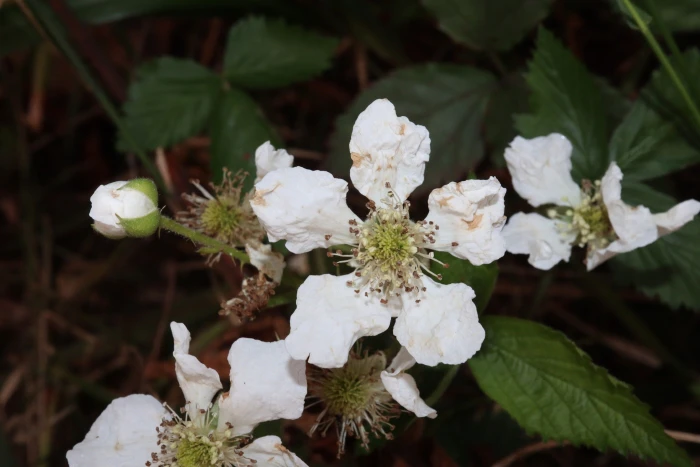Plains Blackberry
(Rubus laudatus)
Plains Blackberry (Rubus laudatus)
/
/

© Thomas Mesaglio
CC BY 4.0
Image By:
© Thomas Mesaglio
Recorded By:
Copyright:
CC BY 4.0
Copyright Notice:
Photo by: © Thomas Mesaglio | License Type: CC BY 4.0 | License URL: http://creativecommons.org/licenses/by/4.0/ | Uploader: thebeachcomber | Publisher: iNaturalist |

























Estimated Native Range
Climate Requirements
| • Precipitation | 21" - 67" |
| • High Temp. | 69°F - 94°F |
| • Low Temp. | -9°F - 50°F |
Summary
Rubus laudatus, commonly known as the Plains Blackberry, is a perennial shrub native to various habitats in Central and Eastern United States. It typically grows to a height of 3-6 feet (1-2 meters) with a similar spread. The plant features arching canes with trifoliate leaves and produces white to pale pink flowers in the spring, which are moderately showy and attract pollinators. Following flowering, it bears edible blackberries that are appreciated by wildlife and can be used in culinary applications.
The Praised Blackberry is valued for its fruit production and as a naturalizing plant in gardens. It can be used for border planting, as a natural hedge, or for erosion control on slopes. This shrub prefers moist, well-drained soils and can tolerate a range of light conditions from full sun to partial shade. While it is not particularly drought-tolerant, it can adapt to various soil types if adequate moisture is provided. Gardeners should be aware of its potential to spread aggressively through root suckers and should manage its growth accordingly to prevent unwanted naturalization.CC BY-SA 4.0
The Praised Blackberry is valued for its fruit production and as a naturalizing plant in gardens. It can be used for border planting, as a natural hedge, or for erosion control on slopes. This shrub prefers moist, well-drained soils and can tolerate a range of light conditions from full sun to partial shade. While it is not particularly drought-tolerant, it can adapt to various soil types if adequate moisture is provided. Gardeners should be aware of its potential to spread aggressively through root suckers and should manage its growth accordingly to prevent unwanted naturalization.CC BY-SA 4.0
Plant Description
- Plant Type: Shrubs
- Height: 3-5 feet
- Width: 3-6 feet
- Growth Rate: Moderate
- Flower Color: White
- Flowering Season: Spring, Summer
- Leaf Retention: Deciduous
Growth Requirements
- Sun: Full Sun, Part Shade
- Water: Medium
- Drainage: Medium
Common Uses
Bird Garden, Butterfly Garden, Edible*Disclaimer: Easyscape's listed plant edibility is for informational use. Always verify the safety and proper identification of any plant before consumption.
Natural Habitat
Forest margins, thickets, and slopes in mountainous regions
Other Names
Common Names:
Scientific Names: Rubus laudatus , Rubus ablatus , Rubus condensiflorus , Rubus congruus , Rubus cupressorum , Rubus gattingeri , Rubus interioris , Rubus par , Rubus praepes , Rubus pulchriflorus
GBIF Accepted Name: Rubus laudatus